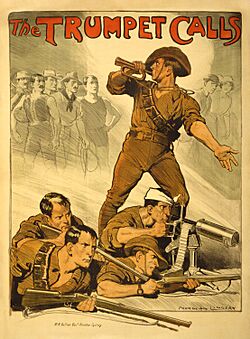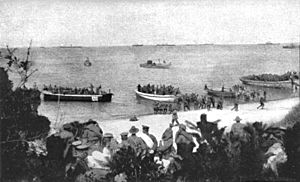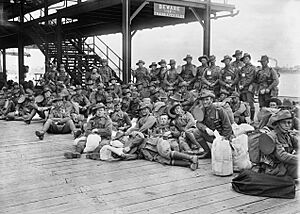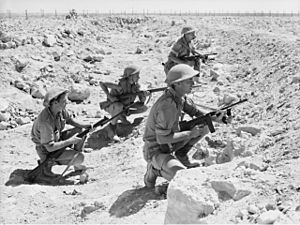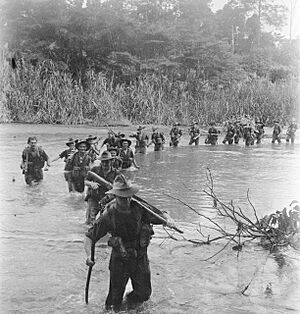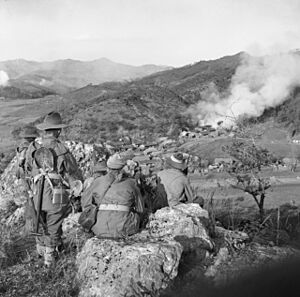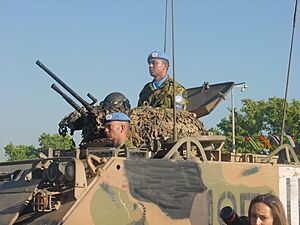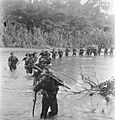History of the Australian Army facts for kids
The Australian Army has a long and interesting history, going back more than 120 years! It started from the British Army and smaller military groups in the Australian colonies before Australia became one country. These groups slowly joined together between 1899 and 1903, creating the Australian Army we know today. When Australia became the Commonwealth of Australia on 1 January 1901, these colonial forces officially united. The Army was first called the 'Commonwealth Military Forces'. In 1916, it became the 'Australian Military Forces', and in 1980, it was finally named the 'Australian Army'.
For over 80 years after the first British colony was set up, the only professional soldiers in Australia were British troops. By 1870, when these British soldiers left, the six separate Australian colonies had their own part-time reserve groups, called 'militia' or 'volunteers'. After some tough times and worker protests that the colonial forces helped stop, Australians became a bit wary of large, permanent armies. They preferred having a big citizen army trained by a small group of professionals. This idea lasted for a long time, even until after World War II.
The Australian Army has been part of many important world events. These include the Boer War, World War I and II, the occupation of Japan, the Korean War, conflicts in Malaya and Borneo, the Vietnam War, and more recently, wars in Afghanistan and Iraq.
Contents
Early Beginnings
In January 1788, when the First Fleet arrived, the New South Wales Marine Corps came ashore. They were the first modern soldiers on the Australian continent. For over 80 years, British soldiers were the main professional military presence in Australia. Their job was to protect the colonists and keep order, especially among the convicts. In 1791, the Marines were replaced by the New South Wales Corps, also known as the Rum Corps. Local volunteer groups, called 'loyal associations', helped them. These were formed in 1801 because people worried about convict uprisings.
Later, the Governor's Body Guard of Light Horse was created in 1803 from citizens. A company of the NSW Corps also went to Van Diemen's Land (now Tasmania) to help set up a new colony there. The Rum Corps caused some trouble, including the famous 'Rum Rebellion'. Because of this, they were replaced by the 73rd (Perthshire) Regiment of Foot in 1810, and the local militias were also disbanded.
During the colonisation of Australia, some colonial forces were involved in the Australian frontier wars. These were conflicts and sad events against Indigenous Australians. A very difficult time was in 1828, when the Governor of Van Diemen's Land declared martial law. This started a conflict called the Black War, which lasted until 1832.
The first major conflicts where many Australian-born soldiers fought overseas were the New Zealand Wars (1863-1872). Most of these 2,500 men served with New Zealand colonial units or the British Army. By 1870, when British soldiers left, the six Australian colonies had their own part-time reserve units, called militia or "volunteers." The colonial governments also started to create professional artillery units to manage coastal defences. From 1877, British officers came to advise the colonies on defence. In the early 1880s, the first meetings about defence between the colonies were held.
In 1885, New South Wales sent an infantry battalion with artillery to a short British campaign in Sudan. During a tough economic time in the early 1890s, big worker strikes happened. Governments sometimes used or threatened to use militia against the strikers. This was very unpopular. It led to successful efforts against creating large, permanent armies. A "two armies" system was set up: only militia units would be infantry, but permanent artillery and support units remained. As the colonies moved towards Federation, the colonial artillery units joined together on 24 August 1899. This was the first federal army unit in Australia.
Early Conflicts
Boer War
Before Australia became a single country, the six independent Australian colonies sent soldiers to South Africa for the Second Boer War. The colony of Queensland was the first to offer 250 mounted troops in July 1899, even before the war officially started.
The first Australian troops arrived in November 1899. A group called the Australian Regiment was an infantry unit made up of volunteers from Victoria, Tasmania, South Australia, and Western Australia. They sailed on one ship to Cape Town. Because of how the war developed, these infantry troops were changed into mounted infantry, meaning they fought on horseback.
The Boer forces put up strong resistance, which led to more Australians joining the war. These new soldiers were often called Bushmen's Contingents. They were usually volunteers who were good at riding horses and shooting but didn't have much military experience. After Australia became a federation in 1901, eight Australian Commonwealth Horse battalions were sent.
Many Australian units had short tours of duty and some were reorganised. Later, some Australians joined multinational units, like the Bushveldt Carbineers. Famous figures like Harry "Breaker" Morant served in these units.
Australian units fought in many important battles. These included the relief of Mafeking, Sunnyside, Slingersfontein, Pink Hill, the Relief of Kimberley, Paardeburg, Bloemfontein, the Siege of Eland's River, Rhenosterkop, and Haartebeestefontein. Australians were also part of the capture of Johannesburg and were the first into Pretoria. Later, they fought at Diamond Hill.
In total, 16,175 Australians and 16,314 horses served in the Boer War. Sadly, 251 Australians were killed in action, 267 died from other causes, and 43 went missing. Six Victoria Crosses, a very brave award, were given to Australians. Many Australians served more than once, and some stayed in South Africa after the war.
Boxer Rebellion
The Boxer Rebellion started in China in 1900. Many Western countries, including European powers, the United States, and Japan, sent forces to protect their interests. In June, the British government asked the Australian colonies for permission to send ships from the Australian Squadron to China. These ships carried Naval Brigade reservists, who were trained in both sailing and soldiering. The colonies sent 200 men from Victoria, 260 from New South Wales, and the South Australian ship HMCS Protector.
Among the naval group from New South Wales were 200 naval officers and sailors, and 50 soldiers. These soldiers had originally joined up for the Second Boer War. They wanted to go to China but didn't want to be listed as sailors. The NSW Naval Brigade didn't like having soldiers in their ranks. So, the Army and Navy agreed to call the group the NSW Marine Light Infantry.
Forming the Australian Army
While the Boer War was still happening, the Commonwealth of Australia was created on 1 January 1901. On 1 March, 28,923 colonial soldiers joined the new Australian Army. This included 1,457 professional soldiers, 18,603 paid militia, and 8,863 unpaid volunteers. However, each unit was still run under its old colonial laws. Major General Sir Edward Hutton became the first commander of the Commonwealth Forces on 26 December. He started to create a single structure for the new army.
The Defence Act of 1903 brought all units under one law. Importantly, it stopped the creation of permanent infantry units. It also said that militia forces could not be used in worker disputes and could not serve outside Australia. Most soldiers remained in militia units, now called the Citizen Military Forces (CMF). In 1911, two big changes happened after a report by Lord Kitchener. The Royal Military College, Duntroon was set up, and a system of universal national service began. Boys aged 12 to 18 became cadets, and men aged 18–26 had to serve in the CMF.
World War I
When the United Kingdom declared war on Germany, starting World War I, the Australian government quickly joined the fight. This was expected by most Australians because many people were born in Britain or had British parents. By the end of the war, almost 20% of Australian soldiers were born in the UK, even though most joined in Australia.
Because the existing Citizens Forces couldn't fight overseas, an all-volunteer force was created. This was the Australian Imperial Force (AIF), formed on 15 August 1914. Australia promised 20,000 men. It was set up with one infantry division and one light horse brigade, plus support units. Its first commander was Major General William Bridges.
However, the first action for Australians was closer to home. They seized German colonial outposts in the south-west Pacific and New Guinea. This force, called the Australian Naval and Military Expeditionary Force (AN&MEF), had 2,000 men. They landed near Rabaul on 11 September 1914. After some fighting, the German soldiers surrendered on 21 September.
The AIF left Western Australia on 1 November 1914. They were first sent to British-controlled Egypt. This was to stop any attacks by the Ottoman Empire and to open another front against the Central Powers. The AIF had four infantry brigades, with the first three forming the 1st Division. The 4th Brigade joined with the New Zealand infantry brigade to create the New Zealand and Australian Division.
The combined Australian and New Zealand Army Corps (ANZAC), led by British general William Birdwood, went into action on 25 April 1915. This was when Allied forces landed on the Gallipoli peninsula (now celebrated as Anzac Day). The Gallipoli Campaign was a bloody stalemate that lasted eight months. By the end, Australian casualties were 8,700 killed and 19,000 wounded or sick. The AIF continued to grow with the arrival of the 2nd Division, which was formed in Egypt and went to Gallipoli in August.
Western Front
After leaving Gallipoli, the infantry grew a lot. The first four brigades were split to create new brigades (12th, 13th, 14th, and 15th). These new brigades, along with the 4th and 8th Brigades, formed two more divisions (4th and 5th). The 3rd Division was formed in Australia and sailed straight to England for more training. It then moved to the Western Front in November 1916. The light horse brigades had fought without their horses at Gallipoli. In 1916, they got their horses back and formed the 1st Anzac Mounted Division in Egypt. They fought against Turkish forces in the Sinai and Palestine. Australia also provided most of the troops for the new Imperial Camel Corps Brigade.
The first Australian division to launch a big attack on the Western Front was the 5th Division. This attack, the Battle of Fromelles, was a disaster. The division suffered 5,500 casualties with no real gain. The 1st, 2nd, and 4th Divisions, together as I Anzac Corps, fought in the Battle of Pozières and later the Battle of Mouquet Farm, which were part of the Battle of the Somme. In Egypt, the light horse helped stop the Turkish attempt to capture the Suez Canal in the Battle of Romani.
During 1917, the five Australian divisions in France fought in three Allied attacks: the Battle of Bullecourt (part of the Battle of Arras), the Battle of Messines, and the Third Battle of Ypres. Meanwhile, the light horse had moved into southern Palestine. After two attempts to break through Turkish defences at Gaza, a big victory was won in the Third Battle of Gaza. Here, Australians captured the town of Beersheba in a dramatic cavalry charge. By the end of the year, British forces had captured Jerusalem.
The German spring offensive in early 1918 broke through British lines. The five Australian divisions, which had formed the Australian Corps on 1 November 1917, were moved south to help stop the German advance. In May, Australian General John Monash took command of the Australian Corps. The first operation he planned, the Battle of Hamel, is seen as one of the best planned battles on the Western Front. The final Allied attack began with the Battle of Amiens on 8 August. The Australian Corps, along with the Canadian Corps and the British III Corps, led the advance. By the end of September, the Australian divisions were very tired, with only the 3rd and 5th ready for immediate action. On 5 October, the Australian Corps was pulled back to rest and didn't fight again before the war ended.
In the Middle East, the light horse had spent a hot summer in the Jordan Valley. They then led the British attack in the final Battle of Megiddo. The 10th Light Horse Regiment was the first Allied unit to reach Damascus.
A total of 331,814 Australians went overseas to serve in the AIF. This was 13% of all Australian men. About 2,100 women served with the AIF, mostly as nurses. Sadly, 18% (61,859) of those who served in the AIF were killed or died. The casualty rate (killed or wounded) was 64%, which was reportedly the highest of any country in World War I. The AIF remained a volunteer force throughout the war, the only British or Dominion force to do so. Two votes on conscription (forced military service) were defeated, keeping the volunteer status. The AIF also had a higher desertion rate than Britain, mainly because the death penalty was not used.
Between the World Wars
After World War I, the AIF was disbanded on 1 April 1921. The Army was reorganised, focusing on the part-time Militia. This force was rebuilt to have four infantry divisions and two cavalry divisions. Also, three mixed brigades were formed outside the main divisions in Queensland, Tasmania, and Western Australia. These would join the 5th Division if there was a war. The part-time force was kept up by volunteers and compulsory service until the compulsory service plan was stopped in 1929.
A small regular force was maintained during this time. It included the Australian Instructional Corps and the Staff Corps, plus some engineers, medical staff, artillery, and support personnel. Training and staffing were difficult during these years due to limited money from the Great Depression. Equipment was old, and many units were not at full strength.
In 1937, a group of soldiers went to Britain for the coronation of King George VI and Queen Elizabeth. They became the first Australian soldiers in London to mount the King's Guard.
In 1938, the first steps were taken to create a regular infantry force. This was the Darwin Mobile Force. Because of the Defence Act of 1903, this force was officially part of the Royal Australian Artillery, even though it had many infantry soldiers.
World War II
When World War II started in September 1939, the Second Australian Imperial Force (2nd AIF) was formed to fight overseas. The AIF's main strength would be four divisions raised in 1939–1940: the 6th, 7th, 8th, and 9th. Major General Thomas Blamey was made commander of the 2nd AIF. Compulsory military service was introduced: all men over 21 had to do three months of training with the Militia. However, to protect Australia at home, Militia members were not allowed to join the AIF.
After the British forces left France during the Dunkirk evacuation, the 6th, 7th, and 9th Divisions were sent to Egypt. From late 1940, these divisions faced Italian and German forces in the North African Campaign. The 6th Division suffered many casualties in Greece and on Crete, with 3,000 soldiers taken prisoner. The 7th Division led a successful Allied invasion of French-controlled Lebanon and Syria in 1941. The 9th Division and part of the 7th played a famous defensive role at the Siege of Tobruk.
In 1941, the 1st Armoured Division began to be formed as part of the AIF. As worries about war with Japan grew, most of the 8th Division was sent to Singapore to strengthen the British forces there. The remaining battalions were sent to islands north of Australia, like Rabaul, Ambon, and Timor. After short but tough campaigns in Malaya and the islands, almost all of the 8th Division was lost when Japanese forces swept through South East Asia in early 1942. In the Battle of Singapore alone, over 15,000 Australians were taken prisoner. The 6th and 7th Divisions were called back to Australia as the country faced the possibility of invasion. Although British Prime Minister Winston Churchill wanted these two AIF divisions sent to Burma, Australian Prime Minister John Curtin said no. He did agree to land two brigades of the 6th Division in Ceylon (now Sri Lanka) where they helped defend the island in early 1942.
Blamey was appointed Commander-in-Chief in March 1942. In April, a big reorganisation happened. The name First Army was given to I Corps, which grew to army size with Militia divisions. The First Army's first job was to defend Queensland and northern New South Wales. The Second Army was in charge of south-eastern Australia. Other parts of Australia's defences were III Corps (in Western Australia), the Northern Territory Force, and New Guinea Force. Conscription was effectively introduced in mid-1942. All men aged 18–35, and single men aged 35–45, had to join the CMF. Also, the Army's armoured force grew a lot.
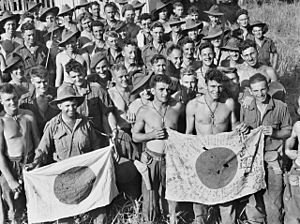
In February 1942, rules changed. If 65% of a Militia unit's official strength, or 75% of its actual personnel, volunteered for the AIF, the unit became an AIF unit. At the time, CMF members were sometimes called "chocolate-tin soldiers" because people thought they would "melt" in battle. However, Militia units showed great bravery and suffered very high casualties in 1942 in New Guinea, which was then Australian territory. A prime example was the 39th (Militia) Battalion. Many of them were very young, untrained, and poorly equipped, but they fought bravely and suffered heavy losses in the tough defence on the Kokoda Trail.
By late 1942, the 7th Division began to relieve the Militia in New Guinea. In August, as the Kokoda battles raged, Militia and 7th Division units formed most of the Australian forces at the Battle of Milne Bay. This was the first clear defeat for Japanese land forces. The 6th and 7th Divisions, with Militia units and parts of the 1st Armoured, were a big part of Allied forces that destroyed the main Japanese beachhead in New Guinea at the Battle of Buna-Gona. In 1943, the Defence Act was changed to allow Militia units to serve south of the Equator in South East Asia. The 9th Division stayed in North Africa and fought bravely at the Second Battle of El Alamein. After this victory, they returned to Australia in 1943. Later that year, they were sent into battle against Japanese forces in New Guinea.
General Douglas MacArthur, the Supreme Allied Commander in the South West Pacific, was sometimes criticised for how he treated Australian forces. After American forces surrendered in the Philippines, Australian ground forces made up almost all of MacArthur's ground forces. As US forces rebuilt, he increasingly used Australian units for less important tasks. The campaign on Bougainville after US forces left is seen as an example of this.
The 1st Army was responsible for clearing up and controlling areas next to the US forces' "island-hopping" campaign towards Japan. Australian units also led the last amphibious attacks during the Pacific War. These were attacks on Japanese-occupied Borneo, including Tarakan, Brunei, British Borneo, Balikpapan, and other targets in Sarawak. Meanwhile, Australian prisoners of the Japanese were often held in terrible conditions, such as Changi prison or in Japan itself. Some were forced into very hard labour, like building the Burma Railway or forced long marches, such as on Sandakan. Many Allied prisoners of the Japanese died.
A planned invasion of Japan's home island of Honshū in 1946, called Operation Coronet, would likely have included a proposed 10th Division made up of existing AIF personnel. This operation never happened as Japan surrendered earlier. Compulsory military service ended in 1945, and most Australian soldiers were sent home by the end of 1946. Out of over 724,000 army personnel during World War II, almost 400,000 served outside Australia. More than 18,000 died, 22,000 were wounded, and over 20,000 became prisoners of war.
Occupation of Japan
The British Commonwealth Occupation Force (BCOF) was a joint force of Australian, British, Indian, and New Zealand military personnel in occupied Japan. It was there from 21 February 1946 until the occupation ended in 1952. Australians made up the largest part of BCOF, and the army made up most of the Australians. The commander of BCOF was always an Australian Army officer. At its peak, BCOF had 40,000 people.
While US forces managed the military government, BCOF was in charge of making sure Japan's military was removed and its war industries were dismantled. BCOF was also responsible for occupying the western areas of Japan. BCOF headquarters was in Kure. The Australian Army helped find and secure military supplies and buildings. They destroyed military materials and kept other equipment for BCOF or returned it to the Japanese. Japanese civilians, supervised by Australians, carried out the destruction or conversion of military equipment for civilian use. Regular patrols were also done to watch over the Australian area.
Meanwhile, plans for post-war defence decided that the Australian Army should have a strong peacetime force. This was a big change from past Australian defence policy, which relied on citizen forces. The Australian Army would now include a permanent force of 19,000 regular soldiers, organised into a brigade of three infantry battalions with armoured support. They would serve alongside a part-time force of 50,000 men in the Citizen Military Forces. The Australian Regular Army was formed on 30 September 1947, and the CMF was re-established on 1 July 1948. The three battalions in the 34th Brigade became the core of the new regular army as the Royal Australian Regiment in 1947, and the brigade itself became the 1st Brigade.
The Australian part of BCOF was responsible for over 20 million Japanese citizens in a 57,000 square kilometre area. During 1947, BCOF began to reduce its presence in Japan. However, BCOF bases were used as stopping points for Australian and other Commonwealth forces going to the Korean War from 1949 onwards. BCOF effectively ended in 1951, when control of Commonwealth forces in Japan was given to British Commonwealth Forces Korea.
In 1953, a group from the army was again sent to the coronation of Queen Elizabeth II. They mounted the Queen's Guard alongside the Canadian Army.
The Cold War Era
Korean War
Malayan Emergency
Although the Royal Australian Air Force had been operating in Malaya since 1950, the first Army battalion, 2nd Battalion, Royal Australian Regiment (2RAR), was sent to Penang in October 1955. However, the battalion didn't get government approval to start operations until January 1956. They then conducted a search and security mission in Kedah. This mission, called Operation Deuce, lasted until late April 1956. Then, 2RAR handed over responsibility to the 1st Battalion, Royal Malay Regiment. In May, 2RAR conducted Operation Shark North in Perak. It was pulled out of combat in August 1957 and left Malaya in October 1957. Sadly, 14 soldiers from the battalion were killed.
In September 1957, 2RAR was replaced by the 3rd battalion, Royal Australian Regiment (3RAR). They began patrols as part of Operation Shark North in December. In January 1958, 3RAR started Operation Ginger, a big operation to stop food supplies to the communist forces. Ginger continued until April 1959, when Perak was declared a safe area. The battalion was pulled out of operations in September 1959, returning to Australia in October. Four soldiers were killed during their time there.
In October 1959, 3RAR was replaced by 1RAR. After a month getting used to the jungle, 1RAR took part in Operation Bamboo, a deep jungle search near the Thai-Malay border. This operation didn't have much success because insurgents could cross into Thailand, where they couldn't be followed. In April 1960, 1RAR began Operation Magnet, the first time Australian forces could cross the border into Thailand. However, Magnet didn't lead to any battles.
In July 1960, the Malayan Prime Minister declared the emergency over. Despite this, 1RAR continued operations until their tour ended in October 1961. Two soldiers from the battalion died during their tour.
From October 1961 to August 1963, 2RAR completed its second tour of duty in Perlis and Kedah.
In 1960, the Army was reorganised into the Pentropic organisation to try and improve its fighting power and match the US Army. However, this organisation didn't work well, and the Army went back to its previous unit structures in 1965.
Vietnam War
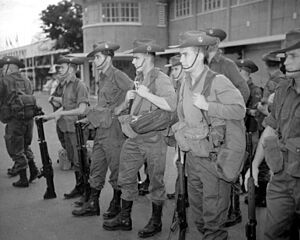
The Australian Army's involvement in Vietnam began with a special group called the Australian Army Training Team Vietnam (AATTV) in 1962. Later, Australian troops and their support units arrived and were assigned to the Phuoc Tuy province. The 1st Australian Task Force was based in this province between 1966 and 1971. It included infantry battalions, a Special Air Service Squadron, an artillery regiment, and supporting engineer, armoured, and armoured personnel carrier squadrons.
While the Army fought few major battles, Australian soldiers fought and defeated large Vietnamese Communist forces during the Battle of Long Tan in 1966 and the fighting around Firebase Coral and the tough operations in the Long Hai hills (1970). The Australian Army was highly trained in jungle warfare. All infantry and combat units completed a difficult jungle training course at Canungra in Queensland before going to Vietnam. In total, about 50,000 Australians served in Vietnam. Sadly, 520 were killed in battles, and many died due to mines.
The Australian way of fighting was different from that used by the United States Army. Australians were very skilled at stealth, patrolling, tracking, searching, and ambushing, and attacking the enemy's sides. In 1970, the 1st Australian Task Force in Phuoc Tuy Province was considered "the most potent allied military force" but was often busy with reconnaissance operations.
The "Forgotten Years" (1972–1990)
In 1988, as part of Australia's bicentennial celebrations, a group of soldiers from the 1st Battalion, Royal Australian Regiment became the first Australian troops in a generation to mount the Queen's Guard at Buckingham Palace in London.
United Nations Transition Assistance Group (UNTAG) 1989–90

In 1979, the UN General Assembly passed Resolution 435. This called for a peacekeeping force to be sent to South West Africa to help it become the independent nation of Namibia. The multinational force was planned to have about 8,000 military personnel and many civilian police. However, due to big problems within the UN and with getting South African forces to leave, the UN force didn't deploy until 1989.
Australia sent a combat engineer force of about 310 soldiers as part of the military force. The Australian group provided engineering support to the UN Force throughout its deployment. Their tasks included many major construction projects, like building roads, airfields, buildings, barracks, schools, and other infrastructure to support the UN. The Australians also helped the Namibian people by building various civil projects.
A notable task was clearing battlefields after twenty years of war. Much of Namibia had been in conflict, and millions of landmines were laid around civilian communities and along the northern border. The removal of these landmines was left to the South African Army. However, tens of thousands remained when South African forces finally left in 1990. The task then fell to the Australians. Despite the significant danger, they achieved a 98% success rate, making many civil communities safe for the first time in decades.
The Australian force rotated once after six months and provided continuous engineer support to the UN and Namibia. The force completed its mission without any deaths, making it one of the few military units in UNTAG to do so. Australia's contribution to UNTAG was a success. As the first deployment of troops to a war zone since the Vietnam War, it paved the way for future deployments.
Recent History (1991–Present)
Gulf War
The Australian Army's involvement in the 1991 Gulf War was small. It included a detachment from the 16th Air Defence Regiment. This group provided close-range defence for the Royal Australian Navy ships HMAS Success and HMAS Westralia. A few Australian officers on exchange with the British and United States armies also served with their assigned units. After the war, an Australian Medical Unit of 75 people, mostly from the Army's 2nd Field Ambulance, was briefly sent to northern Iraq. This was Australia's part in Operation Provide Comfort (called 'Operation Habitat' by the Australian Defence Force). The Australian Medical Unit worked in Northern Iraq between 16 May and 30 June 1991.
Peacekeeping
After East Timor voted for independence from Indonesia, Australian troops were sent in to help control the violence that followed.
War in Afghanistan
Australia was one of many countries that sent troops to Afghanistan. Under Operation Slipper, Australia provided specialist SAS teams to fight against Taliban and Al Qaeda forces.
Iraq War
Australia was one of the countries that sent combat forces for the US-led invasion of Iraq. In Australia, it was known as Operation Falconer. In total, Australia sent about 2,000 personnel. The Army contributed 500 soldiers. After the main combat operations ended, Australia announced it would withdraw most of its forces from Iraq. It left about 950 troops, including naval forces, support troops (like air traffic controllers), and a security detachment of about 75 soldiers to protect important Australian interests.
In February 2005, Prime Minister John Howard announced an increase in the Australian presence by about 450 troops. These troops would protect Japanese troops and help train Iraqi troops. This force, called the Al Muthanna Task Group, was sent to Southern Iraq in May 2005. After Al Muthanna province gained local control in mid-2006, the Australian force changed its role and was renamed the Overwatch Battle Group. This group moved its base to Tallil Air Base, effectively joining with the Australian Army Training Team Iraq (AATTI). Australia's role in Southern Iraq included watching over Al Muthanna and Dhi Qar provinces, doing community support operations, and providing support and training to the Iraqi Security Forces. After the Labor Government came to power in late 2007, most Australian forces were withdrawn from Iraq in mid-2008.
Other Events
In 2000, the Federation Guard was formed. This was a unit with members from the army, RAN, and RAAF. Their job was to serve as ceremonial guards during the celebrations of Australia's Centenary of Federation the following year. In July 2000, a group mounted the Queen's Guard in London for three weeks. This group included four women, led by Captain Cynthia Anderson. They were the first women ever to serve as guards at Buckingham Palace.
In August 2009, an alleged plan to attack the Holsworthy Barracks was discovered by the Australian Federal Police. The alleged plot was to storm Holsworthy Barracks, an Australian Army training area in Sydney, with automatic weapons. The goal was to shoot army personnel or others until they were killed or captured.
Images for kids
See also
- Battle and theatre honours of the Australian Army
- Uniforms of the Australian Army


